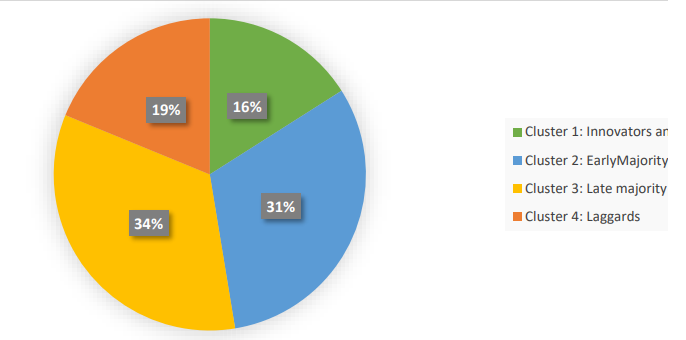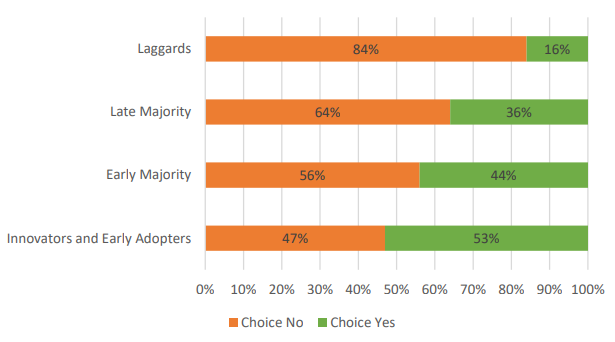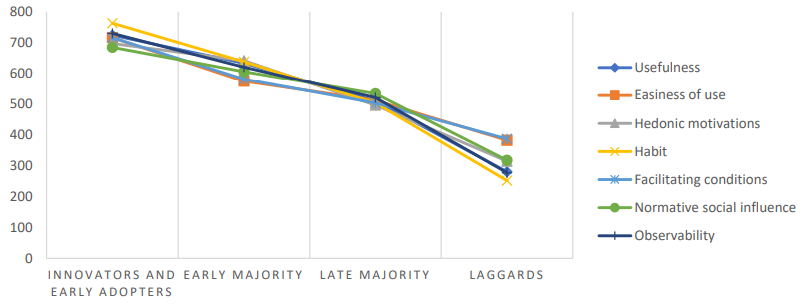Understanding the role of personal innovativeness, attitudes and perceptions in the shift towards Mobility as a Service (MaaS)
Editie: 30 - Shifts in the Real Estate Industry
Published on: 01 juni 2023
From Automobility to Mobility as a Service, the Changing Landscape of Urban Mobility
The current form of urban mobility is the result of changes in transportation and technology systems, as well as shifts in economic, institutional and sociocultural practices (Grubler, 1990).
If we look at the last 100 years, two main paradigm shifts in urban mobility can be identified. The first one dates back to the early 20th century, and it is commonly referred to as “automobility” (Urry, 2004). It identifies the transition from non-motorized modes of transportation and rail-based mass transit to motorized private mobility changed not just transportation but also cities, affecting land use patterns, urban life and individual travel behaviors. This transition in a car-based regime structure aroused through a series of interacting processes (Smith et al., 2010), encompassing technological and social elements. The second one started a few decades ago. We are assisting to a new shift towards a post-private car mobility system (Dowling and Simpson, 2013), due to the significant economic, environmental and social impacts associated with automobility. Emerging trends such as electric cars, connected and autonomous vehicles, car sharing, carpooling, ride sourcing and other forms of demand responsive transport are transforming urban mobility and challenging the concept of automobility. As one can certainly observe, the car is still a fundamental element of these mobility services. However, the crucial change is the way cars are owned, used and experienced. All these mobility initiatives can be viewed as forerunners of a more comprehensive mobility paradigm known as Mobility as a Service (MaaS).
A Look into the Concept, Development and Challenges of MaaS
MaaS is a new concept in the transportation field, which emerged a decade ago. It is based on the use of digital platforms and novel business models, as well as a new regulatory framework, to offer mobility as an integrated provision of all available means of transportation (e.g. public transportation, shared and on demand modes) and their relative digital services (e.g. real time information, booking, ticketing). Freedom, flexibility and seamlessness typically associated to the use of private cars are expected to still characterize the travel experience of MaaS end-users. In fact, the goal of MaaS is to reduce the reliance on private car ownership and change citizens’ travel behavior in favor of a more sustainable and smart way of traveling. As a novel ecosystem, MaaS implies substantive changes in the set of governance schemes, business models, and supply and demand models in urban planning and transportation. Thus, an increasing body of knowledge emerged to understand how this innovative concept can be successfully developed.
In the current literature, MaaS is often described as an innovation that is expected to fulfil user travel needs in a novel way and change people’s conventional ways of thinking about transport in the long term (Caiati et al., 2020). However, history has shown that many innovations fail due to their inability to address real user needs and preferences or their incompatibility with user values and past experiences (Rogers, 1962). Therefore, investigating potential demand for MaaS is crucial for the design of these services and the deployment of business models and governance schemes aimed at facilitating the transition from a private car-based mobility model to a service-oriented one based on digital platforms and sustainable transportation modes.
Exploring the Adoption of Mobility as a Service (MaaS)
The existing studies on the potential adoption of MaaS focus the attention on individual preferences for MaaS features and attributes such as cost, type of subscription and type and pricing schemes of transportation modes included in the services (Matyas and Kamargianni 2018, Ho et al. 2018, Caiati et al., 2020). To have a better understanding of the heterogeneity of preferences among potential users, the effect of individual characteristics, such as socio-demographics and current mobility characteristics, on individual preferences for MaaS adoption is also researched. However, the innovative nature of MaaS suggests that there could be other variables that play a significant role in understanding people’s intention to adopt MaaS. These are the so-called latent attitudes and perceptions. Specifically, it is interesting to study how the theoretical constructs and concepts derived from theories such as the Diffusion of Innovation Theory (DIT) (Rogers, 1962) and the Model of Acceptance and Use of Information Technology (UTAUT) (Venkatesh et al., 2012) can provide a deeper understanding of the MaaS adoption process. Based on these theories, it is in fact possible to identify different MaaS adopters’ categories (i.e. innovators, early adopters, early majority, late majority and laggards) and explore possible differences in attitudes and perceptions towards MaaS by people belonging to distinct categories.
The survey and the applied methods
To collect information on the willingness to adopt MaaS and people attitudes and perceptions towards this new mobility concepts, we conducted a web-based survey involving a total of 1078 respondents from Amsterdam and Eindhoven areas (Caiati et al., 2020). The survey included questions about: (i) sociodemographic and transport related characteristics; (ii) a stated choice experiment to collect data on respondents’ preference to MaaS adoption; (iii) a series of attitudinal questions. Specifically, the respondents’ degree of innovativeness (defined as the degree to which an individual is relatively earlier in adopting new ideas than other members of a social system) was measured by asking them to report to what extent they agreed with the following three statements adapted from DIT using a 7-point Likert scales (from 1=strongly disagree to 7=strongly agree):
- I am usually among the first to try new services and technologies
- I am eager to try new and different services and technologies.
- My relatives and friends often ask me for advice about new services and technologies
Additionally, respondent’s perceptions about MaaS were measured using a set of indicators adapted from DIT and UTAUT. This resulted in a total of 28 statements addressing 7 hypothesized types of latent constructs (i.e. usefulness, easiness of use, hedonic motivation, habit, facilitating conditions, normative social influence, observability). To validate the underlying latent variables, exploratory and confirmatory factor analysis were conducted.
On the basis of the collected data, different methods to classify respondents in adopters’ categories were explored. In particular, cluster analysis was applied as a method to generate accurate and homogeneous adopters’ categories and for deriving the size of adopters’ groups. Respondents’ degree of innovativeness was used as a variable to cluster the sample. Once the clusters were created, statistical tests were applied to explore differences in terms of personal characteristics between these clusters and to understand whether there would be relations between people’s tendency to adopt MaaS and their degree of innovativeness.
Results
Four clusters were revealed within the dataset, as shown in Figure 1. Interestingly, the groups size appeared to be quite similar to the ones defined in DIT (i.e. Innovators 2,5%, Early Adopters 13,5%, Early majority 34%, Late majority 34%, Laggard 16%). We should note also that usually the first two adopters’ categories in DIT are collapsed in one, due to their similar characteristics and the small size of innovators category.

Figure 1: Cluster result by degree of innovativeness
A chi-square test revealed that there are significant relationships between sociodemographics (except household composition and income) and the identified adopters categories. Overall Cluster 1 and 2 are represented by people of younger age groups, students, employed and with middle-high level of education. While cluster 3 and 4 are mainly represented by people of older age groups and retired. Interestingly, females have a high percentage than male in cluster 3 (Late majority). In general, cluster 1 and 2 are represented by higher number of public transport season ticket holders, shared mobility users and travel app users compared to clusters 3 and 4.
For each cluster, the proportion of respondents who stated that they would adopt MaaS (in the stated choice experiment) are reported in Figure 2. As expected, it is observed that people who belong to the category of Innovators and Early Adopters are more willing to subscribe to MaaS compared to the other categories.

Figure 2: MaaS adoption preference by adopters categories
The application of a Kruskal-Wallis test to examine the difference among adopters’ categories in terms of attitudes and perceptions revealed that the distributions of each latent variable differs across adopters categories. Those differences are reported in Figure 3, which shows that the sample average rank of all the UTAUT and DIT constructs follow a descending trend as they move from the adopters’ category of Innovators and Early Adopters to Laggards. This means that individuals belonging to the first category have a higher perception of MaaS as being useful, easy to use, pleasant, and compatible with their current way of travelling, knowledge and resources than other adopters’ categories. Compared to Early/Late Majority and Laggards, Innovators and Early adopters may tend to adopt MaaS not only because of its perceived performance and utility, but also because of their higher perceptions of the social expectations and potential social status gain associated with it.

Figure 3: Differences among adopters’ categories in terms of perceptions
Conclusions
“The shift in urban mobility is not only about technology, it’s about people”
Based on the above results, we can say that latent variables such as personal innovativeness can help to understand potential adoption of MaaS because they reveal underlying motivations and beliefs about this new service. For example, people with higher degree of innovativeness may have a more positive perception of the usefulness, compatibility and the ease-of-use MaaS. Therefore, they are more likely to start using it before the majority of people.
Latent variables allow to identify the key factors that may have an influence on MaaS adoption and diffusion, and these can inform policies and strategies for adapting the service to different groups of potential users characterized by different needs and perceptions.
To conclude, a successful shift towards post-private car mobility system based on innovative services (such as MaaS) requires taking into consideration not only the technical and financial aspects of it, but also the behavioral aspects and the diversity of people’s perceptions and preferences.
Over de auteur: V. Caiati
| Valeria Caiati is a researcher at the Urban Planning and Transportation group in the Department of Built Environment at Eindhoven University of Technology (TU/e). Her research focuses on smart and sustainable mobility with special attention paid to exploring citizens’ adoption of innovative mobility services. |  |
Sources
Caiati, V., Rasouli, S., Timmermans, H., 2020. Bundling, pricing schemes and extra features preferences for mobility as a service: Sequential portfolio choice experiment. Transp. Res. Part A Policy Pract. 131, 123–148.
Dowling, R., Simpson, C., 2013. Shift-the way you move: Reconstituting automobility. Continuum (N. Y). 27, 421–433
Ho, C.Q., Hensher, D.A., Mulley, C., Wong, Y.Z., 2018. Potential uptake and willingness-to-pay for Mobility as a Service (MaaS): A stated choice study. Transp. Res. Part A Policy Pract. 117, 302–318.
Grubler, A., 1990. The rise and fall of infrastructures: dynamics of evolution and technological change in transport, Utilities Policy. Heidelberg: Physica-Verlag, Germany.
Matyas, M., Kamargianni, M., 2018. The potential of mobility as a service bundles as a mobility management tool, in: TRB 2018 Annual Meeting.
Rogers, E.M., 1962. Diffusion of Innovations, 1st ed. Free Press of Glencoe, New York.
Smith, A., Voß, J.P., Grin, J., 2010. Innovation studies and sustainability transitions: The allure of the multi-level perspective and its challenges. Res. Policy 39, 435–448.
Urry, J., 2004. The ‘System’ of Automobility. Theory, Cult. Soc. 21, 25–39.
Venkatesh, V., Thong, J.Y.L. & Xu, X., 2012. Consumer Acceptance and Use of Information Technology: Extending the Unified Theory of Acceptance and Use of Technology. MIS Quarterly, 36(1), pp.157–178.
Mail the editors